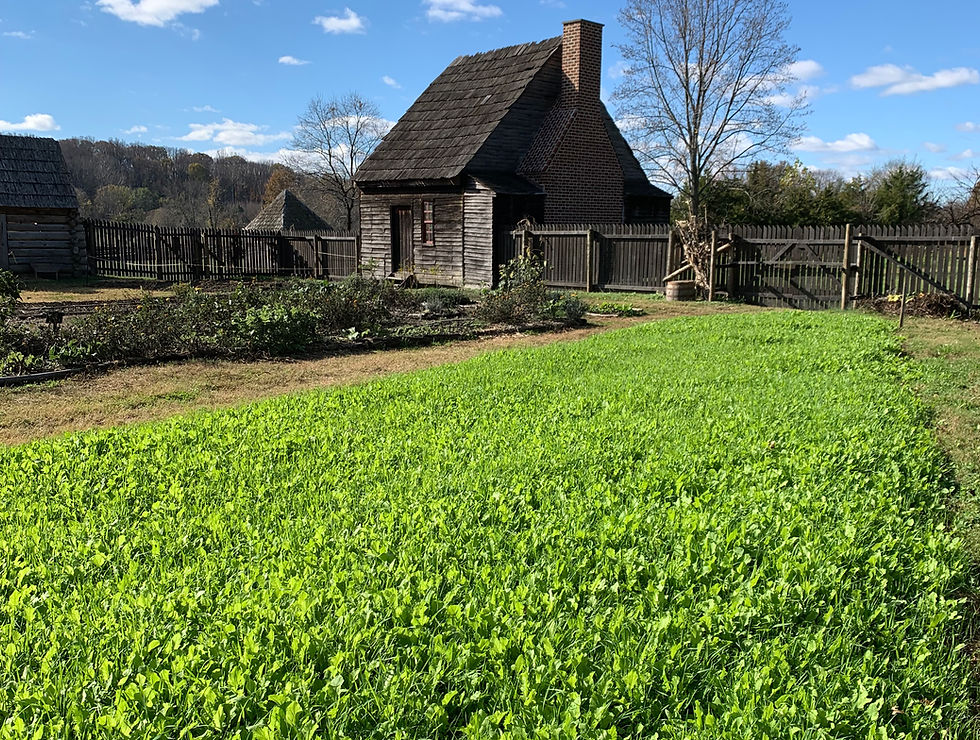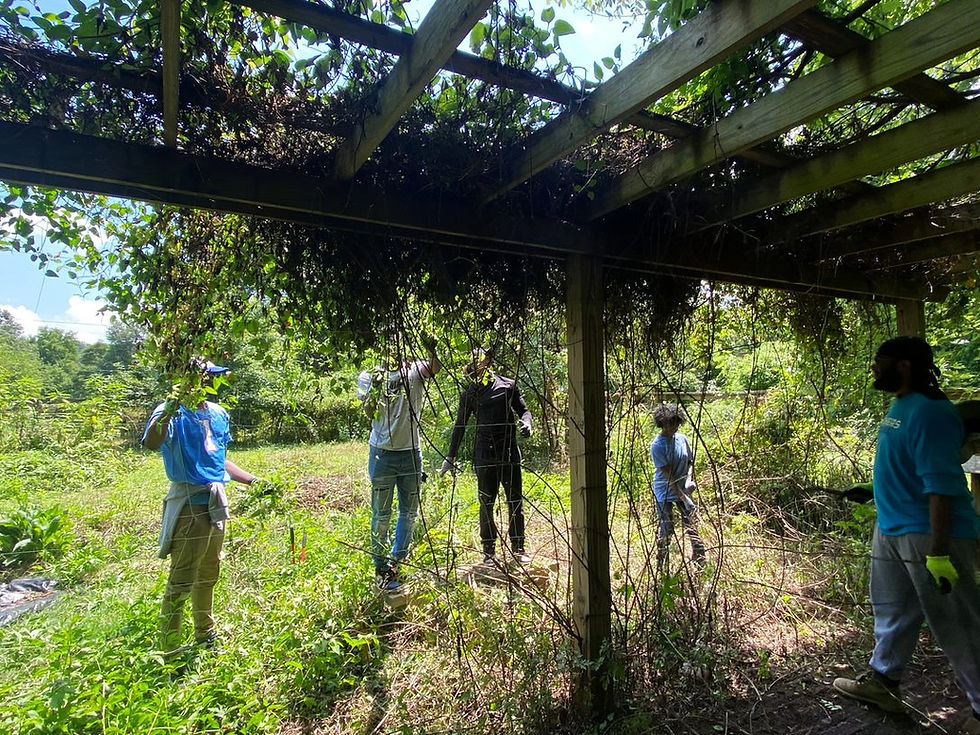Field Notes: Volume 16, Number 6
- Accokeek Foundation

- Jun 10, 2011
- 4 min read

This Week’s Harvest
Parsley
Garlic Scapes
Head Lettuce
Green Onions
Cucumbers
Summer Squash
Kohlrabi
Beets
While we strive for consistency at the Ecosystem Farm, we ask that our SHAREholders please keep in mind that Friday and Tuesday harvests will not always be the same.
For your convenience, an exact harvest list will be posted in the packing shed.
Things are looking up as the Ecosystem Farm heads into hot weather. While the land could use some rain, and the staff could use an innovative method of controlling those frustratingly prolific squash bugs, work on the farm is rolling along as the staff continues to get high-summer crops—squash and melons; tomatoes, eggplant, and peppers—into the ground. It’s sad to see some of our spring favorites go, but fresh tomatoes are rather enticing (and should, thanks to the plants in our greenhouses, appear in SHAREs soon).
These tomatoes and other summer-season vegetables will take the place, for instance, of lettuce, the last of which was harvested this week. Although the farm’s head lettuce did make it through Wednesday’s heat, the staff wasn’t so sure it would survive Thursday’s near-record-breaking temperatures without bolting and becoming bitter. Strawberry season has also ended, although SHAREholders are welcome to come scavenge for any remaining fruit.
But accepting and embracing the changing of the seasons is an integral aspect of a life connected to the land. And we are fortunate enough to have plants in the ground, and cause for celebration on the upcoming summer solstice.
To celebrate June 21, the “longest day,” the Accokeek Foundation will honor its members and volunteers (this includes SHAREholders!) with a free Summer Solstice Celebration. Beginning at 5 p.m., the Foundation will offer guided tours of the Ecosystem Farm, followed by food, music, and merriment. Those interested in attending should RSVP no later than Wednesday, June 15, to outreach@accokeek.org or 301-283-2113.
Up Close With Beets
Beets are a member of the Chenopodiaceae, or “goosefoot,” family, so named because the leaves of some of its more prominent members resemble the floppy feet of geese. Relatives of the common beetroot or garden beet include the sugar beet (which accounts for much of the world’s sugar) and the colorful, leafy chard. Chard can be eaten raw, sauteed, or steamed, and makes a good substitute for spinach or other greens in soups, salads, and cooked and baked dishes. Similarly, the leaves of the garden beet can be eaten stir-fried or steamed, although the plant is more often grown for its familiar round root (delicious raw, roasted, or steamed).
According to Rebecca Rupp in her book Blue Corn and Square Tomatoes, American colonists often grew both chard and the garden beet. Rupp writes:
The American colonists toted beets across the Atlantic, where both chard and beetroot, in red, white, and yellow, were well established by the eighteenth century. The opinionated Amelia Simmons mentions them in American Cookery, casting in her lot with the red: “The red is the richest and best approved; the white has a sickish sweetness, which is disliked by many.”
Stuck with “sickish” beets? Rupp also notes the advice of a sixteenth-century gardener on turning your beets red. Said Thomas Hill in the 1570s, “To have the Beete growe redde, water the plant with redde Wine Lees.” Imaginative advice, to be sure, but we’re not so sure it would work here on the Ecosystem Farm.
Below, photos from this week on the Ecosystem Farm. Click images to enlarge, or view them on Flickr.
This Week’s Recipe: Roasted Beets with Parsley Pesto
Recipe from Ginger Beet
Ingredients for pesto:
2 cups parsley leaves, washed and dried
1 large clove garlic, crushed
Zest and juice of 1 medium lemon
1/4 cup walnuts, pine nuts, or pistachios
Pinch salt, or more to taste
1/4 teaspoon freshly ground black pepper
1/2 cup extra virgin olive oil
Ingredients for beets:
1 bunch beets
1 tablespoon salt
Directions:
For pesto: Combine the parsley, garlic, lemon zest and juice, walnuts, salt, pepper, and 1/4 cup of the oil in a food processor or blender. Pulse a few times until the mixture is coarsely chopped. With the motor running, gradually all the remaining oil to form a creamy sauce. Stop the machine occasionally to scrape down the sides, if needed. Taste and adjust the salt as needed.
For beets: Preheat oven to 375 degrees F. Wash beets, trim leaves and roots. Place salt in small bowl; lightly roll each beet in salt, then wrap each in aluminum foil. Place foil-wrapped beets on baking sheet and cook for 30 to 45 minutes, or until tender. Remove beets from the oven, unwrap the foil, then, holding beets under cool running water, remove skin. Cut beets in small pieces and serve with pesto.
Upcoming Events
Sustainable Table: Tuesday, June 14, 2011, 6 to 7:30 p.m., Education Center: It’s one thing to purchase produce that’s in season, and quite another to cook it. Sustainable Table is a monthly cooking course that demonstrates how to use in-season fruits, vegetables, and herbs to create healthful, wholesome, and delicious meals. Each class will spotlight one well-loved fruit or vegetable standard and one unusual item. Participants will receive printed recipes to take home.
Sprouts: Thursday, June 16, 2011, 11 a.m. to Noon, Education Center: It’s never too early to get out and garden! Sprouts is a garden-themed educational program that spotlights fruits, vegetables, and other parts of a backyard garden. The class features fun activities for parents and children to do together, from singing songs and reading stories to making crafts and playing games. We will spend time outside when weather permits. This month, we will learn about colors in the garden.
Monthly Foodways: We Are Very Deficient In Our Gardens: Saturday, June 18, 2011, Noon to 1 p.m., National Colonial Farm: Join us for a kitchen table conversation as we introduce you to the epicurean delights of colonial Marylanders. This month’s theme is “We Are Very Deficient In Our Gardens.” Learn what Colonial Americans and African American slaves grew for food and why. Tobacco took up massive blocks of time that made gardening a challenge. Learn about heirloom vegetables and how many food traditions stem from these forgotten ingredients. This month’s menu will include The Art of the “Pickle,” Stewed Peas and Lettuce, Onion Soup, and Peas Porridge.







